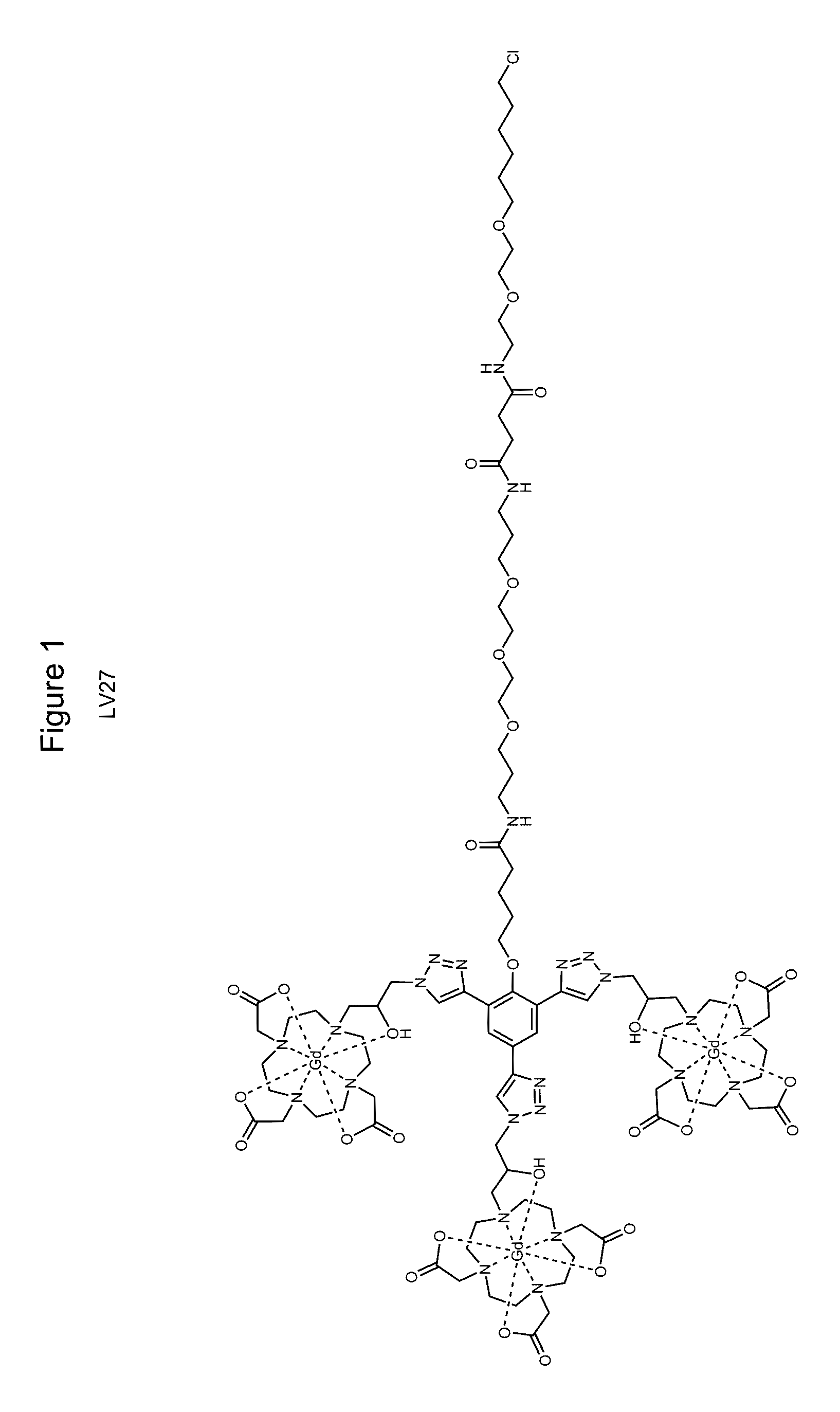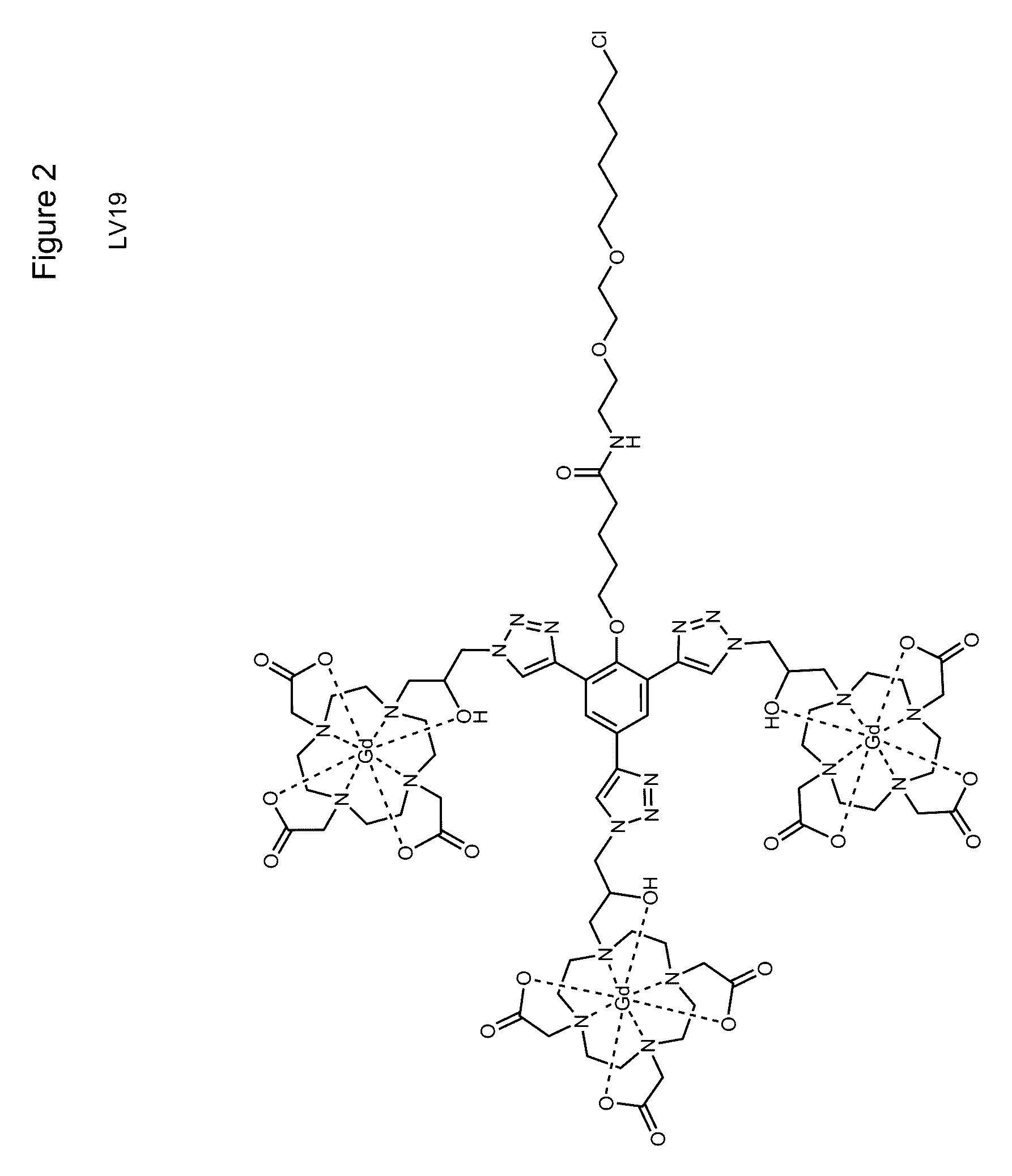MRI contrast agents
a contrast agent and contrast technology, applied in the field of mri based imaging, can solve the problems of limited effectiveness, limited deep tissue resolution, and non-specificity of contrast agents, and achieve the effect of brightening images and positive contras
- Summary
- Abstract
- Description
- Claims
- Application Information
AI Technical Summary
Benefits of technology
Problems solved by technology
Method used
Image
Examples
example 1
[0061]Both target compounds were produced using common synthesis techniques. A first goal was to produce the compounds indicated in FIGS. 1 and 2 which will be referred to as LV27 and LV19 respectively. Intermediates of these compounds were purified through the use of silica gel chromatography and characterized through electron spray ionization mass spectroscopy (ESI-MS) and nuclear magnetic resonance (NMR). ProN3, the compound displayed in FIG. 3, was then attached to these intermediate compounds using click chemistry to yield the final product displayed in FIGS. 1 and 2. The final products were then purified by HPLC and characterized by MALDI.
[0062]The synthesis of the target compounds was relatively straightforward. Previous research produced C3-Acid (FIG. 4) and ProN3 (FIG. 3), and the remaining steps involved synthesizing the linker region between the C3-Acid and the HaloTag ligand. LV19 was produced from a peptide coupling of C3-Acid to the reactive linker (FIG. 7) followed ad...
example ii
[0072]This example describes the synthesis of a series of four MR probes containing a Gd(III) chelate and a haloalkane substrate connected by linkers of varying lengths (FIG. 12). These derivatives were designed to systematically shorten the distance between the Gd(III) chelate and the surface of the protein in order to exploit a receptor-induced magnetization enhancement (RIME) (see, e.g., Aime, S.; J. Biol. Inorg. Chem. 2000, 5, 488; Caravan, P.; J. Am. Chem. Soc. 2002, 124, 3152; each herein incorporated by reference in its entirety) effect and to optimize binding to the protein. It was hypothesized
[0073]that restricting the local motion of the Gd(III) chelate near the flexible linker would result in longer rotational correlation times and, therefore, increased relaxivity. The complexes are referred to by the number of carbons in the linker excluding the carbonyl carbon, the HaloTag targeting group, and the Gd(III) ion (1CHTGd, 2CHTGd, 3CHTGd, and 4CHTGd).
[0074]The synthesis of t...
PUM
| Property | Measurement | Unit |
|---|---|---|
| molar ratio | aaaaa | aaaaa |
| pH | aaaaa | aaaaa |
| flip angle | aaaaa | aaaaa |
Abstract
Description
Claims
Application Information
 Login to View More
Login to View More - R&D
- Intellectual Property
- Life Sciences
- Materials
- Tech Scout
- Unparalleled Data Quality
- Higher Quality Content
- 60% Fewer Hallucinations
Browse by: Latest US Patents, China's latest patents, Technical Efficacy Thesaurus, Application Domain, Technology Topic, Popular Technical Reports.
© 2025 PatSnap. All rights reserved.Legal|Privacy policy|Modern Slavery Act Transparency Statement|Sitemap|About US| Contact US: help@patsnap.com



